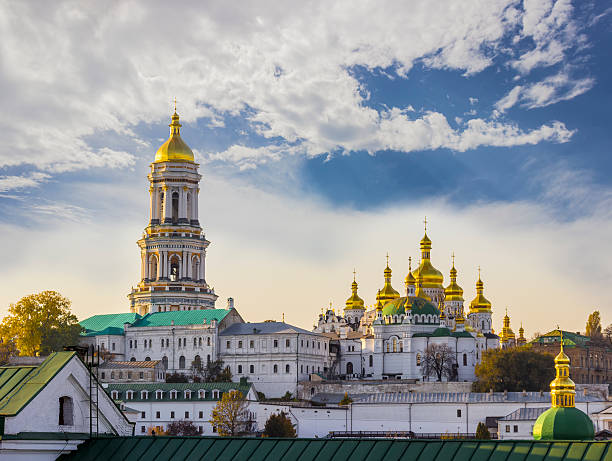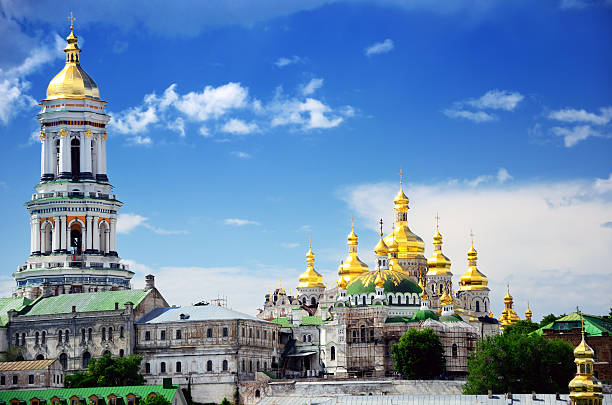Saint-Sophia Cathedral and Kyiv-Pechersk Lavra: UNESCO-Recognized Pillars of Ukrainian Heritage, Cultural Identity, Religious History, Spirituality and National Resilience
Kyiv, the historic capital of Ukraine, is home to two of Eastern Europe's most significant religious and architectural treasures: the Saint-Sophia Cathedral and the Kyiv-Pechersk Lavra (Monastery of the Caves). Together, these sites form a UNESCO World Heritage Site that represents the spiritual heart of Kyivan Rus' and the evolution of Ukrainian religious and cultural identity over nearly a millennium. This comprehensive examination will explore their historical foundations, architectural splendor, artistic masterpieces, political significance, and contemporary challenges, providing a thorough understanding of why these monuments remain vital to Ukraine's heritage.

Historical Foundations and Early Development
The origins of Saint-Sophia Cathedral are shrouded in scholarly debate, with two primary theories about its foundation. The traditional view, based on the Primary Chronicle, attributes its construction to Grand Prince Yaroslav the Wise in 1037 to commemorate his decisive victory over the nomadic Pechenegs in 1036 . However, more recent research by historian Dr. Nadia Nikitenko and others suggests an earlier foundation date of 1011 under Yaroslav's father, Vladimir the Great, who Christianized Kyivan Rus' in 988 . This earlier date gained official recognition in 2011 when Ukraine and UNESCO celebrated the cathedral's millennial anniversary.
The cathedral's name derives from the Hagia Sophia in Constantinople (modern Istanbul), meaning "Holy Wisdom" rather than being dedicated to a saint named Sophia . This naming was intentional, as Yaroslav sought to position Kyiv as a rival to Constantinople, the center of Eastern Christianity. The cathedral served as the spiritual, political, and cultural center of Kyivan Rus', hosting grand ducal inaugurations, holy councils, ambassadorial receptions, and political agreements . It also housed the first known library in Rus' and was where chronicles were maintained, making it an intellectual as well as religious hub.
Kyiv-Pechersk Lavra's origins trace back slightly later to 1051 when the monk Anthony, returning from Mount Athos in Greece, sought solitude in caves near Kyiv . His disciple Theodosius organized the growing community into a formal monastery that would become the most important center of Orthodox Christianity in Eastern Europe. The monastery's name "Pechersk" derives from the Ukrainian word for caves ("pechery"), referring to its famous underground complexes where monks lived, prayed, and were buried . Unlike Saint-Sophia's princely patronage, the Lavra began as an ascetic retreat that gradually gained prominence through spiritual authority rather than political power.
Both sites survived the Mongol invasion of 1240, though not unscathed. Saint-Sophia was looted and partially destroyed, losing much of its former splendor though remaining Kyiv's main functioning church . The Lavra's underground caves provided some protection, allowing monastic life to continue even during these turbulent times. Their survival through this catastrophe ensured the preservation of Kyivan Rus' cultural and religious traditions during centuries of foreign domination.

Architectural Evolution and Byzantine Influences
Saint-Sophia Cathedral represents a masterpiece of 11th-century Byzantine architecture adapted to local traditions. Constructed by Byzantine masters with local builders, the cathedral originally featured 13 domes - a central high dome symbolizing Christ as head of the church surrounded by 12 smaller domes representing the apostles . This configuration was unusual for Byzantine architecture and may reflect local preferences or symbolic meanings. The cathedral measures 41.7 meters long and 54.6 meters wide, with the central dome reaching 28.6 meters high .
The building technique employed "mixed brick-stone masonry" using large natural stones (granite and rose quartzite) with brick gaskets, creating distinctive two-toned striped patterns on the unplastered exterior walls . The interior followed the cross-domed plan typical of Byzantine churches but with adaptations like five naves (instead of the usual three) and five apses, creating a more expansive interior space . The cathedral was surrounded by two-tier galleries on three sides, another feature that distinguished it from Constantinopolitan prototypes .
Over centuries, the cathedral underwent significant modifications that transformed its exterior while preserving its Byzantine core. The most dramatic changes occurred during the 17th-18th centuries under Metropolitan Petro Mohyla and Hetman Ivan Mazepa, who commissioned Italian architect Octaviano Mancini to rebuild the upper portions in the Ukrainian Baroque style . This reconstruction added elaborate Baroque gables, decorative moldings, and pear-shaped domes while carefully maintaining the original Byzantine interior. Mazepa also funded the construction of a magnificent 76-meter tall bell tower in 1699, a landmark of Cossack Baroque architecture with intricate stucco ornaments and bas-reliefs .
Kyiv-Pechersk Lavra developed as an extensive architectural ensemble over several centuries. Its earliest structures were the cave systems themselves - narrow underground tunnels with small niches for hermits and burial chambers. As the monastery grew, surface buildings were added including the Dormition Cathedral (1073-1078), destroyed in 1941 during World War II but reconstructed in the 1990s . The Lavra's architectural character was largely shaped by 17th-18th century additions in Ukrainian Baroque style, including the Great Lavra Bell Tower (96.5 meters tall), the Refectory Church, and numerous residential and administrative buildings .
The Lavra's layout reflects its dual nature as both spiritual center and fortress. High stone walls with defensive towers enclose the Upper Lavra, while the Lower Lavra contains the famous cave systems. This defensive posture was necessitated by frequent attacks, including the Mongol invasion and later Crimean Tatar raids . The architectural ensemble harmoniously blends Byzantine, Gothic, Renaissance, and Baroque elements into a distinctly Ukrainian synthesis that evolved over nine centuries of continuous development.

Artistic Treasures and Iconographic Programs
Saint-Sophia Cathedral houses one of the world's most complete ensembles of 11th-century Byzantine mosaics and frescoes, covering approximately 260 square meters of mosaics and 3,000 square meters of frescoes . These artworks were created by Byzantine masters shortly after the cathedral's construction and follow a carefully planned theological program reflecting the heavenly hierarchy.
The central dome originally featured a mosaic of Christ Pantocrator (now lost), while the main apse preserves the magnificent 6-meter tall Virgin Orans (Praying Virgin), known as the "Unbreakable Wall" for its symbolic protection of Kyiv . The golden background of the mosaics creates a luminous effect, with predominant blue, purple, and grey-white tones creating a solemn yet majestic atmosphere . The Communion of the Apostles mosaic in the main altar and the Deisis (Christ with the Virgin and John the Baptist) in the central apse are particularly fine examples of Byzantine liturgical art.
The frescoes include both religious and secular subjects unusual for Byzantine tradition. Alongside standard biblical scenes and saintly portraits (about 250 preserved examples), there are depictions of Yaroslav's family, hunting scenes, musicians, and even a rare image of the Hippodrome in Constantinople . These secular images reflect Kyiv's political connections with Byzantium and the cathedral's role as a dynastic monument . The princely group portrait in the central nave may represent either Vladimir or Yaroslav's family, underscoring the interconnection of religious and political authority .
Kyiv-Pechersk Lavra's artistic heritage is equally significant though more varied chronologically. The caves preserve 11th-century burial niches with mummified remains of saints and monks, creating a powerful spiritual atmosphere . The above-ground churches contain outstanding examples of Ukrainian Baroque iconography, including works by renowned artists like Ivan Rutkovych. The Lavra's icon collection grew over centuries through donations, commissions, and its own workshops, representing various schools of Eastern Christian art .
Particularly noteworthy is the Lavra's role in developing printed religious art. Its printing press, established in the early 17th century, produced books, paper icons, and devotional prints that spread Ukrainian Baroque styles throughout the Orthodox world . About 3,500 woodblocks from this workshop survive, demonstrating the Lavra's importance as a center of religious publishing . The synthesis of Byzantine traditions with local innovations created a distinctive Ukrainian sacred art that influenced Russian and other Orthodox cultures.
Political and Religious Significance Through Centuries
The history of these sites reflects Ukraine's complex political and religious evolution. Saint-Sophia served as the necropolis for Kyivan rulers including Yaroslav the Wise, whose marble sarcophagus remains in the cathedral . After the Mongol devastation, both sites declined until the Union of Brest (1596) brought Saint-Sophia under the Ukrainian Greek Catholic Church, which initiated repairs . The 1633 restoration to Orthodox control under Metropolitan Petro Mohyla marked a cultural revival, with the cathedral becoming a bulwark of Orthodox identity against Catholic expansion .
The 18th century saw both sites flourish under Cossack patronage, particularly Hetman Ivan Mazepa, whose Baroque reconstructions expressed Ukrainian cultural aspirations . However, Russian imperial policies gradually suppressed Ukrainian autonomy, and after the 1917 Revolution, both faced Soviet persecution. Saint-Sophia was nearly destroyed in the 1930s (like the nearby St. Michael's Golden-Domed Monastery) but saved by international protests and converted into a museum in 1934 . The Lavra suffered confiscation of property, repression of monks, and damage during World War II, though it too became a museum preserve .
Post-1991 Ukrainian independence brought new challenges. Religious groups - Ukrainian Orthodox Church (Moscow Patriarchate), Orthodox Church of Ukraine, and Greek Catholics - all claimed Saint-Sophia, leading to violent clashes like during Patriarch Volodymyr's funeral in 1995 . It remains a state museum where occasional services are permitted to different denominations . The Lavra was leased to the Moscow Patriarchate until 2023, when Ukraine's government transferred control to the Orthodox Church of Ukraine due to the former's ties with Russia after the 2022 invasion . This reflects how these sacred sites remain entangled in contemporary geopolitical struggles.
UNESCO Recognition and Current Status
UNESCO inscribed "Kyiv: Saint-Sophia Cathedral and Related Monastic Buildings, Kyiv-Pechersk Lavra" as a World Heritage Site in 1990 based on four criteria:
World Heritage Site in 1990 based on four criteria:
Representing a masterpiece of human creative genius (criterion i)
Exhibiting important interchange of human values in architecture and art (criterion ii)
Bearing unique testimony to a cultural tradition (criterion iii)
Being an outstanding example of building ensemble illustrating significant stages of history (criterion iv)
The designation recognized their roles as:
Centers of Orthodox Christianity that influenced religious and cultural development across Eastern Europe
Preservers of 11th-century Byzantine art and architecture
Examples of Ukrainian Baroque synthesis
Sites of continuous historical significance for over 900 years
In September 2023, UNESCO added both sites to its List of World Heritage in Danger due to risks from Russia's war against Ukraine . This aims to mobilize international protection efforts, though the lack of enforcement mechanisms limits practical effects. The designation acknowledges both direct threats from potential attacks and indirect damage from nearby bombings' shockwaves . Ukrainian authorities have implemented protective measures like sandbagging and structural reinforcements, while international organizations provide emergency conservation support.
Today, Saint-Sophia operates primarily as the "National Reserve 'Sophia of Kyiv'" museum complex, attracting scholars and tourists to its preserved artworks and architecture . The Lavra remains partially monastic while functioning as the "National Kyiv-Pechersk Historic-Cultural Preserve," with ongoing tensions between preservation, worship, and political agendas . Both sites were named among Ukraine's "Seven Wonders" in 2007, testifying to their enduring cultural importance .
Conclusion: Living Monuments to Ukrainian Identity
Saint-Sophia Cathedral and Kyiv-Pechersk Lavra embody Ukraine's complex historical trajectory from Kyivan Rus' through Mongol rule, Polish-Lithuanian dominion, Cossack autonomy, Russian imperialism, Soviet atheism, to modern independence. Their architecture and art represent creative syntheses of Byzantine, Western, and local traditions that shaped distinct Ukrainian cultural expressions. As religious sites, they have been centers of spiritual life, theological education, and pilgrimage for nearly a millennium.
Perhaps most significantly, these monuments have become symbols of Ukrainian national identity and resilience. Their survival through invasions, wars, and ideological persecution mirrors Ukraine's own endurance as a nation. The current threats from Russian aggression add another chapter to this long history of challenge and preservation. As UNESCO's danger listing emphasizes, protecting these sites is not merely about conserving old buildings but safeguarding the living heritage of Ukrainian culture and its deep roots in European civilization. Their continued existence stands as testament to Ukraine's historical depth and cultural achievements that no invasion can erase.
Photo from: iStock
0 Comment to "Saint-Sophia Cathedral and Kyiv-Pechersk Lavra: UNESCO Treasures Symbolizing Ukrainian Cultural Heritage, Spiritual Legacy, and National Resilience"
Post a Comment